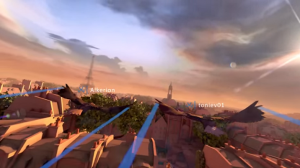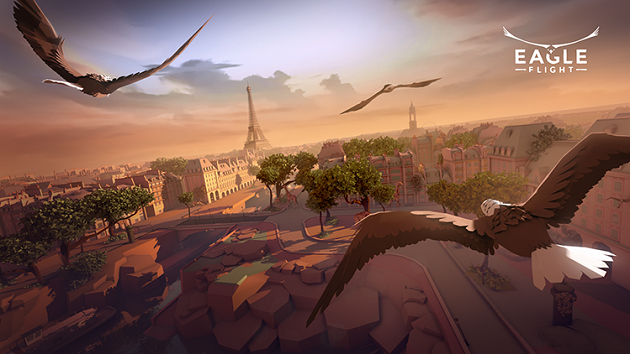It doesn’t take long to spot the ‘Ubisoft formula’ in Eagle Flight. Those that have played any of the many entries in the Far Cry and Assassin’s Creed series over the past few years will know what this means; you have an open world that is littered with events and collectables that you’re free to set about completing and gathering. It’s a tried and true system that ensures you have plenty to do, and there’s an undeniable, statistical satisfaction that comes with slowly crossing out a long list of activities.
But there’s also been some resistance to that formula of late, most evident in the recent announcement that there will be no new Assassin’s Creed this year. In Eagle Flight, however, any fatigue you might have felt beforehand quickly subsides thanks to VR.
Eagle Flight is Ubisoft’s first real venture into this new technology, and all signs are pointing towards the company handling it right. As the name suggests, you’re cast as an eagle that soars above the streets of a Paris that has been reclaimed by nature. As you gently glide along canals and wind through leafy streets, herds of deer emerge from around corners, unphased by your presence, while one spot in a river holds a pack of elephants calmly quenching their thirst, completely unaware that they are, quite literally, an elephant in a room they shouldn’t be in.
This a secret paradise, an idealised French capital in a world which man no longer occupies. And that soothing peace that surrounds is the perfect complement to the tone set by the breezy locomotion mechanics utilised. Eagle Flight is played with a gamepad, but its navigation relies almost completely on head-tracking. You simply look in the direction you want to travel and you tilt your head to make sharper turns. It’s a mechanic already seen in a number of titles – especially on Gear VR – but here it’s fine-tuned, comfortable and frustration-free.
Ubisoft is clearly confident in its systems, too, otherwise it wouldn’t be presenting challenges anywhere near as demanding as what could be seen in this demo. In a single-player portion you’re free to complete races in which you’ll fly through a series of rings as quickly as possible, earning extra time for being as close as possible to the centre of each. There are acclimatisable intro levels in which you’re given plenty of space between each hoop along to get used to first. Then there’s one ‘Hard’ challenge, which this involves nimbly passing through the architecture of the Notre Dame cathedral, scraping against its ancient architecture and spiralling around its towers.
It’s a tough challenge, and something that could get messy if the navigation wasn’t as smooth as it is. The fact that VRFocus could take multiple attempts at the course without feeling the need to rest or getting any motion sickness is testament to the strength of the design. It also helps that the player’s peripheral vision is ever so partially obscured, with your eagle’s beak and feathers in plain view.

The area on display here was sizeable, though notably restricted. The Eiffel Tower pierces the background, inviting you to swing over and dance around its complex structure. It’s not a part of this first area, however, and you’re quickly instructed to make your way back. Presumably the map will expand as you complete missions.
As anyone that saw Eagle Flight’s introduction at a PlayStation press conference last year will know, multiplayer is also a big component of this title. VRFocus was able to sample a 3 vs 3 capture the flag-type game mode in which players compete to grab a piece of bait and bring it back to their home base.
For this to work, of course, Eagle Flight needs some form of combat. Eagles can emit a deafening screech that shoots out in front of the player. You trade fire with the enemy team and one hit will cause your opponent to burst into a disturbing cloud of what seems like red confetti. It’s important to sweep the area and fend off any opposition before going in for the bait, as you’ll quickly be taken out otherwise.
There are pros and cons to this approach. On one hand, getting to grips with Eagle Flight’s multiplayer is frustrating, as you’re constantly attacked from behind and the screen with suddenly fade to black. When under fire, the screen with flash red, but that doesn’t give you any aid in actually avoiding said fire. You simply have to start weaving a desperate path around the city streets, keeping low and praying the enemy’s aim is poor. On the other hand, when you do have the bait this can be a heart-thumping experience. It really captures a feeling of being hunted; a thrill not yet experienced in VR.
The big takeaway from Eagle Flight thus far seems to be that it’s shaping up to be both a compelling single and multiplayer experience and not just one or the other. Ubisoft has created a smooth and yet, when you want it to be, demanding experience here. Even with the company’s formula firmly in place, this is strikingly different from anything else in its upcoming catalogue, and hopefully something that VR players can really sink their teeth into later this year.















